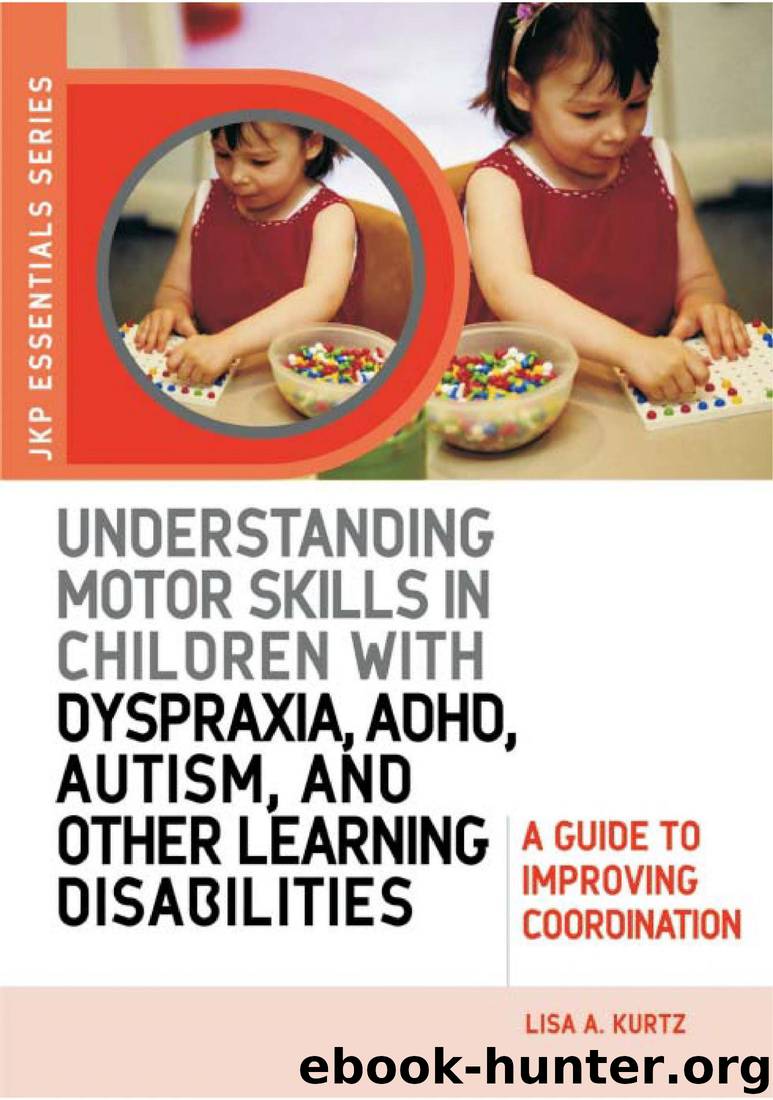Understanding Motor Skills in Children With Dyspraxia, ADHD, Autism, and Other Learning Disabilities: A Guide to Improving Coordination (JKP Essentials) by Lisa A. Kurtz

Author:Lisa A. Kurtz
Language: eng
Format: mobi
Tags: 9781843108658
ISBN: 1843108658
Publisher: Jessica Kingsley Publishers
Published: 2007-10-14T21:00:00+00:00
8 0
U N D E R S T A N D I N G M O T O R S K I L L S
both hands to propel; put one foot on the carpet and use the other leg
to propel).
• Practice jumping or hopping games such as hopscotch, leapfrog,
jumping jacks, cheerleading moves, or jumping to “patterns” on a
trampoline (e.g. right, right, left, left or right, left, clap, right, left, clap).
• Hold one crepe-paper streamer in each hand and practice various
bilateral patterns.
• Hold one piece of chalk in each hand. Standing at a blackboard, practice
drawing shapes, patterns, or letters using both hands at the same time
with the eyes closed. Encourage the child to try to make the right-hand
picture look the same as the left-hand picture.
• Lie on the floor and pretend to make “angels in the snow” with eyes
open and eyes closed. Vary the patterns—for example, moving the right
arm and left leg while the other limbs remain still.
Balance skills
Balance is another important component of motor skill in the developing child.
Balance skills are based upon input from several sensory modalities. Perhaps of
greatest importance is the vestibular sense, which provides input to the central
nervous system about gravitational pull, motion, and speed. Some children with
inadequate sensory processing of vestibular input may be overly sensitive, causing
them to get dizzy easily and to avoid activities that include strong movement expe-
riences. Children with this sort of problem often show a strong preference for
maintaining their head in a position of vertical alignment with the world, and avoid
such activities as hanging upside down on a monkey bar, performing somersaults,
or lying back on a piece of equipment that rocks or is otherwise unstable. Others
with vestibular difficulties are undersensitive to vestibular input, and may seek out
extra movement experiences in an effort to “fuel” their central nervous system
with meaningful information.
Balance is also highly dependent on proprioceptive feedback. Movement in
any part of the body should result in unconscious, automatic postural adjustments,
often subtle, in other parts of the body. For example, when a right-handed child
writes a sentence on a piece of paper, the hand moves along a path that causes the
body to shift weight and the head to turn slightly toward the right, thus allowing
smooth movement of the arm across the page. These subtle body adjustments are
sometimes referred to as postural background movements, and help the body to
move fluidly and as a whole unit. Visual feedback is also a factor in maintaining
P R O M O T I N G B A S I C M O T O R S K I L L S
8 1
balance. As the body moves, so do the visual images that reach the central nervous
system, providing additional cues that the body needs to make adjustments in
response to the situation. You may have had the experience of watching a spinning
toy or carnival ride, and feeling dizzy as a result. This illustrates the close relation-
ship between the visual and vestibular systems. You may have also learned that
fixating on a stable visual target when attempting to balance on one foot may
improve your performance.
Download
This site does not store any files on its server. We only index and link to content provided by other sites. Please contact the content providers to delete copyright contents if any and email us, we'll remove relevant links or contents immediately.
The Art of Coaching Workbook by Elena Aguilar(50120)
Trainspotting by Irvine Welsh(21035)
Twilight of the Idols With the Antichrist and Ecce Homo by Friedrich Nietzsche(18303)
Fangirl by Rainbow Rowell(8794)
Periodization Training for Sports by Tudor Bompa(7929)
Change Your Questions, Change Your Life by Marilee Adams(7384)
This Is How You Lose Her by Junot Diaz(6451)
Asking the Right Questions: A Guide to Critical Thinking by M. Neil Browne & Stuart M. Keeley(5360)
Grit by Angela Duckworth(5302)
Red Sparrow by Jason Matthews(5199)
Paper Towns by Green John(4805)
Room 212 by Kate Stewart(4741)
Ken Follett - World without end by Ken Follett(4449)
The Sports Rules Book by Human Kinetics(4079)
Housekeeping by Marilynne Robinson(4070)
Double Down (Diary of a Wimpy Kid Book 11) by Jeff Kinney(3933)
Papillon (English) by Henri Charrière(3913)
Exercise Technique Manual for Resistance Training by National Strength & Conditioning Association(3790)
The Motorcycle Diaries by Ernesto Che Guevara(3789)
